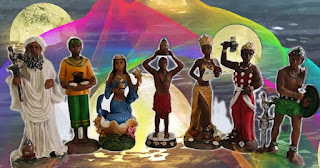Orishas, Oshas and Ortolans
 |
| Image Courtesy: https://ashepamicuba.com/en/que-son-los-orishas/ |
Elizabeth Peréz’s Religion in the Kitchen opened my eyes to a culture I was unfamiliar with, and I was amazed by what I learned. I knew very little about Black Atlantic religions, and I felt that this book, with it’s rich descriptions of the kitchen as a place of religious practice, the preparation and use for the food, and the roles and micropractices of everyone involved, was an excellent and thorough introduction to Lucumí culture (as thorough as can be without actually going to Chicago and breathing it all in). At times I was surprised by the intensity, attention to detail, social hierarchies and traditions that were associated with the food prepared for the orishas and other members of Ilé Laroye. I think this is because I was not raised in a particularly religious environment, and as a child I rarely ever thanked God or a high power for a meal. In my house, food was mainly just cooked for necessity, and only for enjoyment when there was something to celebrate. As I've gotten older, though, I see why it feels so good to acknowledge the religious aspect of food and to eat with purpose and intent.
This reading made me realize the massive role food preparation has in religious contexts. My parents are big fans of the late Anthony Bourdain, and a few months ago my mom read me an excerpt from his book, Medium Raw. In the passage below, he describes eating a rare bird called the ortolan, a French bird about the size of a human thumb. Since 1999, it has been illegal to cook or consume the bird, as it is now an endangered animal. Unfortunately, it is still served to the elite at a very high price, and prepared in a seriously disturbing way, so CW if you read the article I have linked at the end of this post.
Bourdain writes, “I bring my molars down and through my bird’s rib cage with a wet crunch and am rewarded with a scalding hot rush of burning fat and guts down my throat. Rarely have pain and delight combined so well. I’m giddily uncomfortable, breathing in short, controlled gasps as I continue slowly – ever so slowly – to chew. With every bite, as the thin bones and layers of fat, meat, skin, and organs compact in on themselves, there are sublime dribbles of varied and wondrous ancient flavors: figs, Armagnac, dark flesh slightly infused with the salty taste of my own blood as my mouth is pricked by the sharp bones. As I swallow, I draw in the head and beak, which, until now, have been hanging from my lips, and blithely crush the skull.”
 |
Image Courtesy: Richard Cottenier/MAXPPP with the New York Times https://www.nytimes.com/2014/10/15/dining/the-ortolan-a-tiny-songbird-as-a-french-cause-celebre.html |
When eating the ortolan, diners place a shroud over their heads “hiding the shameful act, supposedly, from the eyes of God”, and also to increase their experience of the aromas and taste. As a vegetarian, Bourdain's description made me literally squirm in discomfort, but I can't ignore how powerful and descriptive this passage is. This class, and particularly this book, reminded me of this example because it is a deeply sensory, and for some people, religious experience. However, there are certainly differences between your typical ortolan consumer and members of the ilé.
A major difference is that most members of the ilé are not wealthy. On page 74, an ilé elder described herself as “poor”, and another woman told Peréz that when her children were growing up, she would announce a special “egg drop soup night” to get the kids excited about their dinner, when in reality eggs and sachets of chicken noodle soup were all that she could afford. This culture places a strong emphasis on the importance of family, kitchens, cooking and food preparation and I believe that is why it is so tight knit. When the ilé are not dining in communion with each other or the orishas, they are often talking about it or preparing for it.
These examples have taught me that virtually all cultures across the globe crave a sense of community and a connection to a higher power, relying on sensory experiences, and particularly food, to achieve this.
https://www.the-tls.co.uk/articles/anthony-bourdain-pain-pleasure/


Comments
Post a Comment